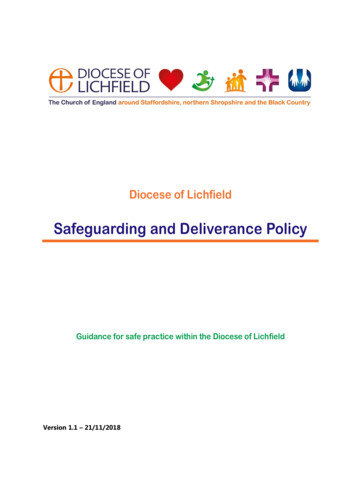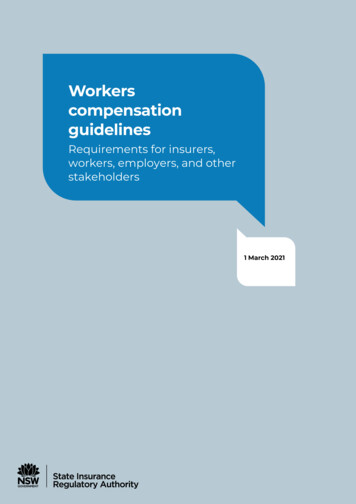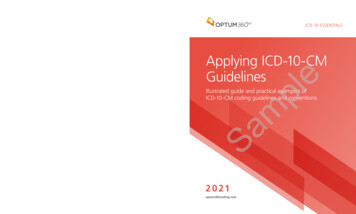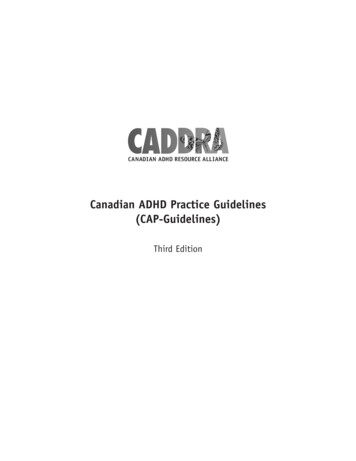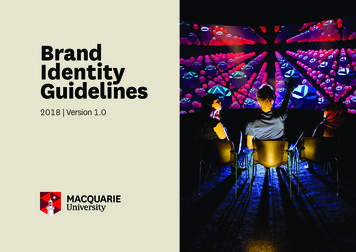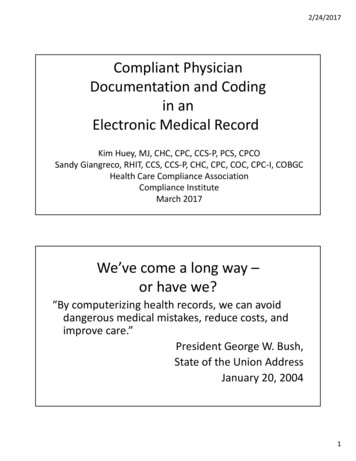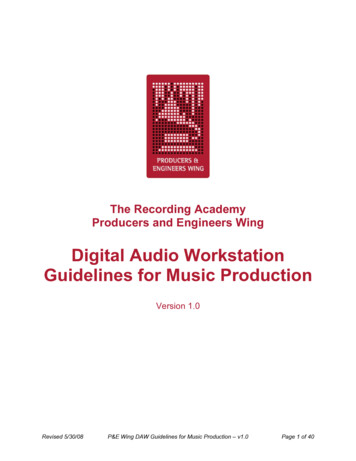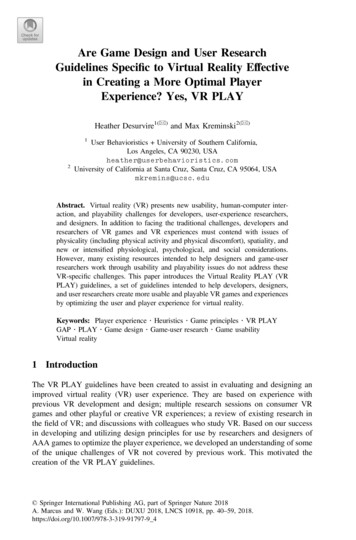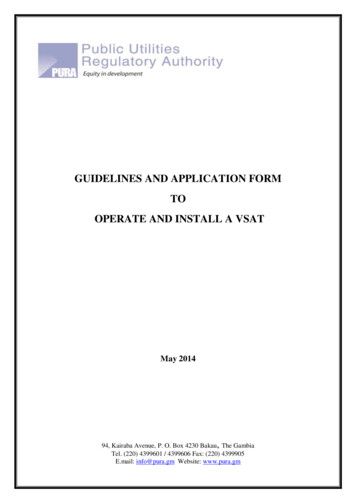
Transcription
Higher Education:Guidelines for LearningAgreement for StudiesGuidelines on how to use the LearningAgreement for StudiesThe purpose of the Learning Agreement is to provide a transparent and efficient preparation of the studyperiod abroad and to ensure that the student will receive recognition in his/her degree for the educationalcomponents successfully completed abroad.This template is applicable to Erasmus mobility for studies between Programme Countries (KA103) and toErasmus mobility for studies between Programme and Partner Countries (KA107).It is recommended to usethis template. However, if higher education institutions already have an IT system in place to produce theLearning Agreement or the Transcript of Records, they can continue using it, provided that all the minimumrequirements listed in this document are made available. Further fields can be added, if needed (e.g.information on the coordinator of a consortium), and the format (e.g. font size and colours) can be adapted.BEFORE THE MOBILITYAdministrative dataBefore the mobility, it is necessary to fill in page 1 with information on the student, the Sending and theReceiving Institutions. The three parties have to agree on this section to be completed before the mobility.In case some administrative data is already available to the three parties, there is no need to repeat it in thistemplate.On page 1, most of the information related to the student, Sending and Receiving Institutions will have to beencoded in the Mobility Tool .Educational components (Tables A and B)The study programme includes the indicative start and end months of the agreed study programme that thestudent will carry out abroad.The Learning Agreement must include all the educational components to be carried out by the student at theReceiving Institution (in Table A) and it must contain as well the group of educational components that will bereplaced in his/her degree by the Sending Institution (in Table B) upon successful completion of the studyprogramme abroad. It is necessary to fill in Tables A and B thoroughly before the mobility. Additional rowsand columns can be added as needed. However, the two Tables A and B must be kept separated. The objectiveis to make clear that there is no need to have one-to-one correspondence between the components followedabroad and the ones replaced at the Sending Institution. The aim is rather that a group of learning outcomesachieved abroad replaces a group of learning outcomes at the Sending Institution.In countries belonging to the European Higher Education Area (EHEA) an academic year of full-time study isnormally made up of educational components totalling 60 ECTS credits. It is recommended that for mobilityperiods shorter than a full academic year, the educational components selected should equate to a roughlyproportionate number of credits (or equivalent units in countries outside the EHEA). In case the studentfollows additional educational components beyond those required for his/her degree programme, theseadditional credits (or equivalent) must also be listed in the study programme outlined in Table A.In case of thesis research/doctoral work at the receiving institution, the component "Thesis research" or"Doctoral work" will be included in Table A. If no ECTS credits are provided by the receiving institution, it is1
Higher Education:Guidelines for LearningAgreement for Studiessufficient to write "not applicable" in that column. The thesis/doctoral work and the associated workload inECTS credits will be included in Table B, if relevant for the sending institution.The Sending Institution should indicate in Table B the group of educational components counting towards thestudent’s degree that would normally be completed at the Sending Institution and which will be replaced bythe Study Programme at the Receiving Institution. The total number of ECTS credits (or equivalent) in Table Bshould correspond to the total number of ECTS credits (or equivalent) contained in Table A. Any exception tothis rule should be clearly stated in an annex of the Learning Agreement and agreed by all parties. Example ofjustification for a discrepancy in the total number of ECTS credits (or equivalent) between Table A and TableB: the student has already accumulated the number of credits required for his/her degree and does not needsome of the credits gained abroad.The group of components can be included in Table B as follows:Recognition at the Sending InstitutionTable BComponent codeBefore the(if any)mobilityComponent title at the Sending Institution(as indicated in the course catalogue)SemesterNumber of ECTS credits (or equivalent) to be recognised bythe Sending InstitutionCourse XModule YLaboratory WorkThesis research/Doctoral work 10101010 or "Not applicable"Total: 40 (or 30 if not applicable for Thesis research)The European Commission encourages institutions to embed mobility windowsi in their curricula. Where allcredits in Table A are automatically recognised as forming part of the programme at the Sending Institution,typically in the case of mobility windows, Table B is simplified and reduced to one single line, as describedbelow:Recognition at the Sending InstitutionTable BComponent codeBefore the(if any)mobilityComponent title at the Sending Institution(as indicated in the course catalogue)Mobility windowSemesterNumber of ECTS credits (or equivalent) to be recognised bythe Sending Institution Total: 30The Sending Institution must foresee which provisions will apply if the student does not successfully completesome of the educational components from his study programme abroad, by providing a web link.Language competenceA recommended level in the main language of instruction has been agreed between the Sending and ReceivingInstitutions in their Inter-Institutional Agreement. The Sending Institution is responsible for providing supportto its selected candidates so that they can have the recommended language skills at the start of the studyperiod.The level of language competence in the main language of instruction, which the student already has or agreesto acquire by the start of the study period, has to be reported in the box provided for that purpose in theLearning Agreement for Studies or, alternatively, in the grant agreement.In case the level of the selected student is below the recommended one when signing the Learning Agreement(or grant agreement), the Sending Institution and the student should agree that he/she will reach therecommended level by the start of the mobility. They should also discuss and decide the type of support tobe provided to the student by the Sending or Receiving Institution.2
Higher Education:Guidelines for LearningAgreement for StudiesThe Erasmus Online Linguistic Support (OLS) has been designed to assist Erasmus students in improvingtheir knowledge of the main language of instruction, before and during their stay abroad, to ensure a betterquality of learning mobility.For mobility between Programme Countries, and for the languages covered by the OLS, the student must carryout an OLS language assessment before the mobility, and a final assessment at the end of the mobility, exceptfor native speakers and in duly justified cases (e.g. special needs students).The completion of the OLS assessment before departure is a pre-requisite for the mobility. This assessmentwill be taken after the student is selected, before signing the Learning Agreement or, alternatively, the grantagreement.Based on the results of the OLS assessment, the Sending Institution may allocate an OLS language course tothe students who wish to improve their language competences. Mobility participants with a level B2 or higherat the first language assessment in their main language of instruction have the opportunity to follow an OLSlanguage course either in that language or in the local language of the country, provided it is available in theOLS. It is up to the Sending Institution to indicate this choice directly in the OLS.More opportunities for participants following the OLS language courses (OLS Live Coaching: MOOCs, Forumand Tutoring sessions) are available at http://erasmusplusols.eu.Signing the Learning AgreementAll parties must sign the Learning Agreement before the start of the mobility. It is not compulsory to circulatepapers with original signatures; scanned copies of signatures or digital signatures may be accepted, dependingon the national legislation or institutional regulations.DURING THE MOBILITYExceptional Changes to the Study ProgrammeChanges to the study programme should be exceptional, as the three parties have already agreed on a groupof educational components that will be taken abroad, based on the course catalogue that the ReceivingInstitution has committed to publish well in advance of the mobility period and to update regularly.Any party can request changes to the study programme within five weeks after the start of each semester.These changes should be agreed by all parties as soon as possible, within two-weeks following the request.In case of changes due to an extension of the duration of the mobility, a request can be made by the studentat the latest one month before the foreseen end date.All changes should be indicated in Tables A2 and B2, while Tables A and B should not be modified. All Tables(A, B, A2 and B2) should be kept together in all communications. Changes to the study programme abroadshould be listed in Table A2. Please refer to endnote 12 to indicate the reason for change.For example:Exceptional changes to Table A(to be approved by e-mail or signature by the student, the responsible person in the Sending Institution and the responsible person in the Receiving Institution)DeletedAddedTable A2Component title at the ReceivingComponent codecomponent componentNumber of ECTS credits (orDuring theInstitution (as indicated in the courseReason for changeii(if any)[tick if[tick le]XXX YYY 3Choose an item.Choose an item.58
Higher Education:Guidelines for LearningAgreement for StudiesTable B2 should be completed only if the changes described in Table A2 affect the group of educationalcomponents agreed in Table B.Changes of the Responsible person(s)In case of changes of the responsible person(s), the information below should be inserted by the Sending orReceiving Institution, where applicable.Changes of the Responsible person(s)New Responsible person at the Sending InstitutionNew Responsible person at the Receiving InstitutionNameEmailPositionConfirming the ChangesAll parties must approve the changes to the Learning Agreement. The European Commission would like tolimit the use of paper for exchanging documents and it is therefore accepted to exchange informationelectronically, e.g. via email, scanned or digital signatures, etc. without the need of a paper signature.However, if national legislations or institutional regulations require paper signatures, a signature box shouldbe added where needed.4
Higher Education:Guidelines for LearningAgreement for StudiesMobility window: a period of time reserved for student credit mobility that is embedded into the curriculum of a studyprogramme.iiiReasons for exceptional changes to study programme abroad (choose an item number from the table below):Reasons for deleting a component1. Previously selected educational component is not available at theReceiving Institution2. Component is in a different language than previously specified in thecourse catalogue3. Timetable conflict4. Other (please specify)Reason for adding a component5. Substituting a deleted component6. Extending the mobility period7. Other (please specify)Recognition: all the credits (or equivalent units) that the student has earned during the mobility and that were specifiedin the final version of the Learning Agreement as counting towards his/her degree (Table B and, if applicable, B2 of theofficial template) are recognised by the Sending Institution and count towards the student’s degree without the need totake any further courses or exams.iiiivECTS Users' Guide: http://ec.europa.eu/education/tools/ects en.htmvEGRACONS Grade Conversion Tool: https://tool.egracons.eu/5
Steps to fill in the Learning Agreement for StudiesBefore the mobilityProvide study programme.Identify Responsible persons.Commitment of the three parties withoriginal / scanned / digital signatures.During the mobilityIf modifications are needed:A party requests changes within 5 weeks afterthe start of each semester. Agreement by thethree parties has to be reached within 2 weeksafter the request.Request for extension of the duration has to bemade at the latest one month before theforeseen end date.An agreement by the three parties on thechanges is possible via email/digitalsignatures.After the mobilityThe Receiving Institution provides a Transcriptof Records to the student and SendingInstitution normally within 5 weeks afterpublication of the results.The Sending Institution recognises theactivities successfully completed by the studentduring the mobility, counts them towards thestudent’s the degree and registers them in thestudent’s Transcript of Records normally within5 weeks.
All parties must sign the Learning Agreement before the start of the mobility. It is not compulsory to circulate papers with original signatures; scanned copies of signatures or digital signatures may be accepted, depending on the national legislation or institutional regulations. DURING THE MOBILITY Exceptional Changes to the Study Programme
